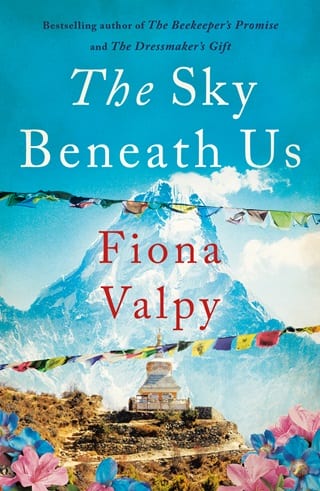Daisy: August 2020
I felt close to Violet in Nepal, but somehow that journey and my return make me feel even closer to her here. After all, this was a childhood home for both of us, and both of us had to leave it. Her only option was to make a new home, on the other side of the world. But my time away has shown me my real home was always back here, where I started. I think it’s the same for Jack as well. We’ve both come home, not only to the place we grew up but to ourselves. To each other. So I’ve decided to remain at Ardtuath.
All of us have had a lot of adaptations to make. Sorcha is able to continue her degree studies online, but Mara’s ambitions in performing arts have been completely curtailed by the pandemic. It’s impacted on the music school too, since the restrictions have brought home to us very forcibly the fact that live performances of all kinds are the first things to be cancelled and the last things that’ll be allowed to restart. I’d worried Mara might be devastated at having to put her dreams on hold indefinitely, but she’s found new purpose in her passion for gardening, partly inspired by Violet’s story. I suspect she shares quite a few character traits with her great-great-great-aunt, not least her determination, her independence and her strength of will. Together, we’ve put up a large polytunnel in the walled garden behind Ardtuath House and begun growing produce there, which Mara sells to local hotels and restaurants, as well as running a farm stall on the pier every Saturday morning for the community. Sorcha helps out when she has the time and has been a useful source of advice, too, when it comes to trying out different crops to plant.
The music school remains closed for now. But we have plans to set up online classes from the autumn, allowing teachers and their students to keep playing. When we’re finally able to reopen, Jack and I will take over the running of the school, although I suspect Mum and Elspeth will continue to keep a close eye on us. So, even though we’re still living through strange times and there are many things we cannot do, we count ourselves very fortunate to have been able to adapt, finding new ways to keep going.
I’m spending a day in Edinburgh, because there’s something I need to do here. This afternoon, I have an appointment at the Botanic Garden where I’ve asked to see the papers of Violet Mackenzie-Grant, which are kept in their archive. I park beside the main gates and go in, carefully stepping on the disinfecting mats that have been placed there. Visitor numbers are limited to keep everyone safe, and even though we’re outdoors, everyone is still wearing masks. The first autumn colours shade the trees with hints of red and brown and the flower beds are filled with yellow rudbeckia and purple asters in a final defiant show of colour before winter arrives. I’m early for my appointment, so before heading to the Library, I meander along the paths and make my way to the Nepalese Garden in the heart of the Botanics. A string of prayer flags waves above a gateway of stones, from which a bronzed bell hangs, transporting me back to the Himalayan pathways leading to Phortse.
I take a photo and send it to Pema. Thinking of you all , my accompanying message reads. I wonder how they are, what they’re doing this evening. I picture them sitting round the stove in the teahouse, perhaps gathering round to look at the picture I’ve just sent if the Wi-Fi’s working there tonight. In my mind’s eye I see their smiles, etched into their faces alongside the hardship that’s written there too, the beautiful combination of kindness and toughness that’s such a Sherpa characteristic.
As I walk on, I stop here and there to peer more closely at the labels beneath the rhododendrons lining the paths. In some cases, the name of the plant hunter who discovered the specimen is acknowledged: Frank Kingdon Ward, George Forrest and George Sherriff feature. But , I mutter beneath my breath, where are the women? Where is Violet?
I take a detour to walk past the Caledonian Hall and stand for a while in front of the pretty Victorian cottage. Nowadays the building’s used as a venue for weddings and other events and the Herbarium’s been moved to the modern, purpose-built science block, which also houses the Library. I imagine Violet walking up to this same doorway with its carved gingerbread gable, plucking up her courage to enter the place where she would find Callum at his workbench. I think she’d like the fact that an alpine garden has been constructed across from it these days. The tumbling stream and low-growing, high-altitude plants would surely remind her of the Valley of Flowers in her home half a world away.
I rouse myself from my reverie and a glance at my watch tells me I need to hurry to my appointment at the Library. Once I’ve sanitised my hands thoroughly and been admitted, I sign in and follow the directions the receptionist gives me from behind his Perspex screen. As instructed, I leave my coat and bag in a locker before being allowed into the archives. The librarian shows me to a table where she’s set out Violet’s papers.
‘I don’t think these have seen the light of day for decades,’ she says. ‘You’re the only one who’s asked for them. Do you have a particular interest in this woman?’
My laugh is muffled by my mask. ‘You could say that,’ I say. ‘She’s a distant relation. I went to Nepal to track her down and discovered her descendants still living there.’
‘Oh, well in that case I think one of my colleagues would like to see you, if you’d be okay with that? When we received your request for this collection, it piqued his interest. He works with the Flora of Nepal team.’
‘I’d love to meet him,’ I say.
‘Great. I’ll let him know you’re here. But for now, I’ll leave you to look through this lot.’ She gestures to the two dog-eared boxes of papers on the desk. ‘Just say if there’s anything else you need.’
I pore over them for an hour or so. They’re mostly lists of the specimens collected by Violet and sent back to Scotland, neatly catalogued in the flowing handwriting that I recognise from her journals. I imagine Hetty would have delivered them to the Botanics – to the Caledonian Hall where I stood just a little earlier – along with the seeds and plant samples. But there are no drawings, no thick paper folders containing the plants she so lovingly, meticulously gathered and prepared. I think of the labels I saw on the rhododendrons in the gardens and wonder again: where is her legacy?
Once I’ve finished looking through them, I replace the papers in their boxes and get to my feet. The librarian must have been watching from her desk by the door because she comes over, saying, ‘My colleague is waiting in the staff canteen, if you still have time to see him?’ Once I’ve retrieved my bag and coat, she points the way down the stairs.
The canteen is empty, apart from a very tall young man sitting at a table in the corner, a cardboard cup sitting in front of him alongside the book he’s reading. His face mask dangles by its elastic from one ear.
I approach him a little uncertainly. ‘Are you Dr Martin Walker?’ I ask.
He unfolds himself, gangly as a stick insect, and extends a bony elbow in the new way it’s now acceptable to greet one another. ‘I am, and you must be Ms Laverock?’
‘Please, call me Daisy.’
He grins. ‘How apt. Are all the members of your family named after flowers?’
‘Pretty much,’ I say with a laugh. ‘Especially the Nepalese branch.’
He raises his eyebrows in surprise. ‘You have family in Nepal? I want to hear all about it,’ he says. ‘Take a seat and I’ll get you a cup of something. Tea? Milk and sugar?’
We sit at the prescribed distance from one another, but I’m able to remove my mask to sip my tea and it feels almost normal for a change.
Martin tells me about the Flora of Nepal project, which has been running for some years now. ‘There’s always been a special link between the Edinburgh Botanics and Nepal, ever since Francis Buchanan-Hamilton’s time. He was the Keeper here in the early 1800s and he’d spent time in the Himalaya before that. We know now, perhaps more than ever before, what a hotspot Nepal is in terms of its biodiversity. And with the way the world is at the moment, it’s becoming more important than ever to map and conserve that wealth of resources before it’s lost forever.
‘There’s still so much we don’t know about the medicinal properties some plants may hold,’ he continues, waving his arms, his passion for his work evident as he gets into his stride. ‘Take the example of the Madagascar periwinkle. It was once used in traditional medicine and when scientists researched it further, they discovered it contained two compounds – vinblastine and vincristine – that reduce the number of white blood cells in the body. Those alkaloids have been developed to provide a key substance used in chemotherapy for the treatment of various cancers. It revolutionised the treatment of childhood leukaemia, in particular. Just imagine how many young lives have been saved by that little plant. Just imagine how many more such discoveries could be out there, waiting to be made.’
‘So would you be interested in talking to people who can tell you more about the plants they use in their traditional medicines?’ I ask.
‘Certainly,’ he replies.
I show him a photo I’d taken of the Tiarella that Pema had picked to make the compress for Themi’s arthritis.
‘This is exactly the kind of thing we want,’ he says. ‘Modern-day plant hunters are citizen scientists, taking photos on their phones rather than digging up specimens. Can you send this photo to me? And put me in touch with your cousin Pema? I’d like to know more about the other plants they use there too.’
We talk for ages, the tea growing cold in our cups, as Martin tells me more about the work he’s been involved in and asks about my trip to Phortse.
‘One thing I don’t understand is where the rest of Violet’s specimens have got to,’ I say. ‘Why are the species sent back by plant hunters like Frank Kingdon Ward recorded out there in the gardens, but there’s nothing of hers?’
He nods. ‘It’s a terrible loss. As you know, the Herbarium was once housed in the Caledonian Hall. But, attractive though it is as a building, it was a bit of a white elephant, never built for scientific purposes. Back in the day, it would have been a damp and airless place to work. It had a terrible old heating system using paraffin oil, which generated so much water vapour it ran down the walls and black mildew grew everywhere. The specimens sent back by Violet were among a significant part of the collection that was lost due to that dampness. Seeds and plant material simply rotted. It’s awful, isn’t it, she went to all that trouble to collect them and send back to the Botanics here in Edinburgh, only for them to end up being destroyed. Thankfully, nowadays we have far better methods of preservation, and the move to the new building here helped too.
‘One of the things I want to do, when I have the time,’ he continues, ‘is to go through Violet’s papers in the archive and see what’s there. It would be good to cross-reference the missing species with those on our main Flora of Nepal database. She may have made some important findings, even though it’s such a tragedy that they will have been lost now.’
‘I have some more photos on my phone,’ I tell him, holding it out for him to see. ‘I took them when Violet’s daughter, Themi, showed me the Valley of Flowers and some of the plants she remembers her mother being especially interested in conserving. Perhaps they might give you an idea too, if you can link them to the notes you have from her.’
He reaches out an angular arm to take my phone from me, nearly spilling cold tea over the table in his excitement as he leans in to get a closer look. ‘Is that Meconopsis horridula ? And what’s that primula growing by the stream? I don’t recognise the exact form ... Well, your photos are certainly a great start, Daisy. Would you be happy to send copies to me? It’s just a shame we don’t have a pictorial record of everything else she discovered.’
I nod slowly. Then I say, ‘What if there were some drawings? Would they be of use? And what if there were some seeds? Do you think they might still be viable today?’
‘That depends. They’d need to have been kept in the right conditions. Cool, dry and dark. And, above all, safe from the damp.’
And then, when I tell him about my discovery of the sketches and the neatly labelled jars of seeds in the waterproof plastic drum that sits in the corner of Themi’s house, the tea finally does go everywhere as he sends his cup flying.
A smile spreads over his face as I describe what I remember seeing. And I smile too, as the realisation dawns that Violet’s legacy may still hold the promise of new life. Thanks to her foresight, she may have saved some of the rarest species of Himalayan plants for generations to come.
 Fullepub
Fullepub 



